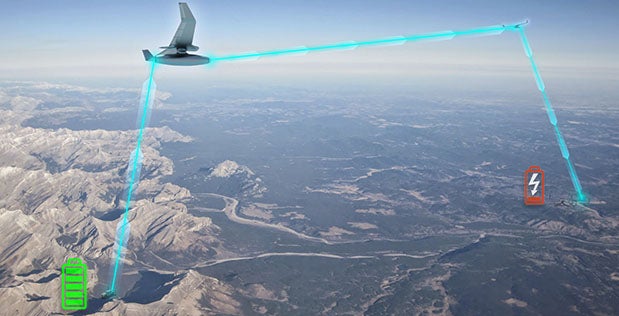
The Defense Advance Research Projects Agency (DARPA) has chosen teams from Raytheon (RTX), Draper Laboratory and BEAM Co. to enter the first phase of the Persistent Optical Wireless Energy Relay (POWER) programme, it announced 7 September.
Energy beaming uses essentially the same physics as wireless communication, according to DARPA. “You need a power source; you convert that power to a propagating wave, typically electromagnetic, send it through free space, collect it in through an aperture, and then convert it back to electricity,” said Col Paul Calhoun, the POWER programme manager, outlining how energy can be transferred wirelessly between two points through the use of optical energy lasers.
The aim behind POWER is to create a network of aerial nodes that can disseminate energy wirelessly to ground-based or other aerial platforms by improving conversion efficiencies for optical energy transmissions. Leverage power beaming in this way can allow for near-instantaneous energy transport.
“This project has the potential to advance power beaming by orders of magnitude, which could radically reshape society’s relationship with energy,” said Dr. Paul Jaffe, who leads the POWER programme at DARPA. “A wireless energy web could unlock power from new and diverse sources, including from space, and rapidly and reliably connect them to energy-starved consumers.”
“This is the internet for energy – harnessing resilient, multipath networks to flow energy from abundant sources to energy-starved consumers,” said Calhoun.
Military applications of wireless energy beaming
For modern armed forces, to physically carry the stored energy that is needed to complete a mission as liquid fuel, military platforms that require long range, endurance, or significant weapons delivery capability must be physically large. A successful POWER relay would mean small, low-cost platforms could conduct the same missions as larger aircraft using wireless power transfer network instead of liquid fuel. The resulting airframes could then be developed with a potentially unlimited range or endurance.
Current technology allows energy beamed from the ground-to ground, but it is possible for energy to be relayed between two aerial platforms in a way that is deeply inefficient interns of energy loss, and imposes additional size weight and power requirements on the airframes.
In this current situation, optical energy can be beamed from the ground station via laser, but at each aerial node the optical energy is converted to electricity to power another laser. The energy loss occurring during the conversion make this process hugely wasteful, and transmission through multiple airborne nodes difficult to imagine.
In a multi-hop network, the conversion losses between propagating waves and electricity are unacceptable. A practical, versatile, and adaptable wireless energy web cannot exist without reliable relays.
The teams selected by DARPA are trying to develop an approach that would keep the energy in its original format, remaining as optical energy when it leaves the ground-based laser and relay it from one aircraft to another without being converted to electrical energy.
The relays will benefit from making transmission at high altitudes, which is much more efficient than sending energy through the denser, more turbulent lower atmosphere. The long-distance, high-throughput skeleton of the wireless energy web will be provided by this optical layer at a high altitude.
The POWER project
The first phase of the POWER programme will last for 20 months and will feature benchtop demonstrations of key technologies, with an optional extension of three months for further risk reduction. As further aircraft could be significantly smaller and cheaper if power is beamed to them, rather than of being generated by the aircraft’s engines and fuel tanks, phase one of the POWER project will also involve the use of conceptual designs to investigate this.
In the second stage, which will begin in early 2025 with an open solicitation, the relay technologies will be integrated onto an existing platform for a low-power, airborne demonstration.
The third stage of program will demonstrate the relays by sending 10 kilowatts of optical energy to a ground receiver located 200 kilometres from the ground source laser via an airborne optical pathway.
Dr. Paul Jaffe, who leads the POWER programme at DARPA, says that the selected teams have taken different routes, each distinct in terms of the demand of research and design. “Each of the selected teams proposed unique technical approaches to the power beaming relay problem, ranging from novel combinations of existing technologies to high-risk, high-reward technological innovations,” said Jaffe.
“The range of proposed solutions encompasses a balance of assured performance and potential breakthroughs in size, weight, and power to enable small distributed systems for the future wireless energy web,” Jaffe continues.
Instant energy transportation changing society
While there are clear benefits to military capabilities from this developing technology, the implications for wider society are not lost on the personnel at DARPA.
Calhoun draws comparisons to how the internet revolutionised access to information. “There’s a lot of energy stored in deep ocean waves the amount of energy that’s happening in waves in the middle of the ocean is enough to power the world many times over but we just can’t get to it it’s not convenient,” said Calhoun, “if we could create a network that moves that energy to places of high need, I believe that you’ll see a similar thing where the accessibility of energy for the average person will be greatly increased, and with that productivity.
“And if we can get to a world where we are no longer tying energy production to carbon, if we’re no longer poisoning our environment by production, if it no longer has to be a balance, that’s a really exciting place to be, because it allows us to unlock production without some of the negative impacts,” says Calhoun. “And there’s a lot of different concepts of how to do energy generation if you’re able to unlock distribution.”
For decades energy sources have been sough as an alternative to carbon-dioxide producing fossil fuels, with some interesting options offered from access to space, including solar production in space, or the use of the Earth’s magnetic field to generate electricity as part of a dynamo with satellites in orbit. However, distribution of this energy has fallen at the first hurdle – but the option to efficiently beam energy from point-to-point opens up the discussion again. \
While Calhoun is clear about the potential to change energy use deeply, he cautions that we are far from seeing widespread application: ”We’ve spent trillions and trillions of dollars setting up our wired infrastructure and our pipes infrastructure and it’ll be a long time before an idea like this would directly compete with those in terms of efficiency.”
However, in the near term certain applications show clear opportunities: “Where it does make sense immediately is places like disaster relief where the infrastructure is gone where your alternative is bringing in liquid fuels to burn in generators all of these things are very inefficient and we can do better than that.”







